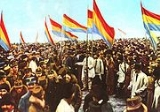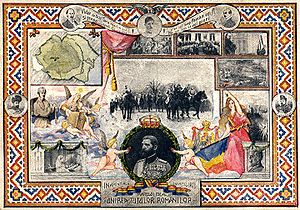
Union Day
Encyclopedia
Great Union Day occurring on December 1, is the national holiday of Romania
. It commemorates the assembly of the delegates of ethnic Romanians held in Alba Iulia
, which declared the Union of Transylvania with Romania
.
This holiday was set after the 1989 Romanian Revolution and it marks the unification of Transylvania
, but also of the provinces of Bessarabia
and Bukovina
with the Romanian Kingdom
, in 1918.
Prior to 1918, the national holiday of Romania was set to be on May 10, which had a double meaning: it was the day on which Carol I
set foot on the Romanian soil (in 1866), and it was the day on which the prince ratified the Declaration of Independence (from the Ottoman Empire
) in 1877.
In Communist Romania
, the date of the national holiday was set to August 23 to mark the 1944 overthrow of the pro-fascist government of Marshal Ion Antonescu
.
Alba Iulia

 On December 1, 1918 (November 18 Old Style
On December 1, 1918 (November 18 Old Style
), the National Assembly of Romanians of Transylvania and Hungary, consisting of 1,228 elected representatives of the Romanians in Transylvania
, Banat
, Crişana
and Maramureş, convened in Alba Iulia
and decreed (by unanimous vote)
The Resolution voted by the National Assembly stipulated also the "fundamental principles for the foundation of the new Romanian State". It was conditional, and demanded the preservation of a democratic local autonomy, the equality of all nationalities and religions.
The Assembly also formed from 200 of its members, plus 50 co-opted members a High National Romanian Council of Transylvania, the new permanent parliament of Transylvania.
The next day, on December 2, 1918 the High National Romanian Council of Transylvania formed a government under the name of Directory Council of Transylvania (Consiliul Dirigent al Transilvaniei), headed by Iuliu Maniu
.
On December 11, 1918, King Ferdinand
signed the Law regarding the Union of Transylvania, Banat, Crişana, the Satmar
and Maramureş with the Old Kingdom of Romania
, decreeing that

Romania
Romania is a country located at the crossroads of Central and Southeastern Europe, on the Lower Danube, within and outside the Carpathian arch, bordering on the Black Sea...
. It commemorates the assembly of the delegates of ethnic Romanians held in Alba Iulia
Alba Iulia
Alba Iulia is a city in Alba County, Transylvania, Romania with a population of 66,747, located on the Mureş River. Since the High Middle Ages, the city has been the seat of Transylvania's Roman Catholic diocese. Between 1541 and 1690 it was the capital of the Principality of Transylvania...
, which declared the Union of Transylvania with Romania
Union of Transylvania with Romania
Union of Transylvania with Romania was declared on by the assembly of the delegates of ethnic Romanians held in Alba Iulia.The national holiday of Romania, the Great Union Day occurring on December 1, commemorates this event...
.
This holiday was set after the 1989 Romanian Revolution and it marks the unification of Transylvania
Transylvania
Transylvania is a historical region in the central part of Romania. Bounded on the east and south by the Carpathian mountain range, historical Transylvania extended in the west to the Apuseni Mountains; however, the term sometimes encompasses not only Transylvania proper, but also the historical...
, but also of the provinces of Bessarabia
Bessarabia
Bessarabia is a historical term for the geographic region in Eastern Europe bounded by the Dniester River on the east and the Prut River on the west....
and Bukovina
Bukovina
Bukovina is a historical region on the northern slopes of the northeastern Carpathian Mountains and the adjoining plains.-Name:The name Bukovina came into official use in 1775 with the region's annexation from the Principality of Moldavia to the possessions of the Habsburg Monarchy, which became...
with the Romanian Kingdom
Kingdom of Romania
The Kingdom of Romania was the Romanian state based on a form of parliamentary monarchy between 13 March 1881 and 30 December 1947, specified by the first three Constitutions of Romania...
, in 1918.
Prior to 1918, the national holiday of Romania was set to be on May 10, which had a double meaning: it was the day on which Carol I
Carol I of Romania
Carol I , born Prince Karl of Hohenzollern-Sigmaringen was reigning prince and then King of Romania from 1866 to 1914. He was elected prince of Romania on 20 April 1866 following the overthrow of Alexandru Ioan Cuza by a palace coup...
set foot on the Romanian soil (in 1866), and it was the day on which the prince ratified the Declaration of Independence (from the Ottoman Empire
Ottoman Empire
The Ottoman EmpireIt was usually referred to as the "Ottoman Empire", the "Turkish Empire", the "Ottoman Caliphate" or more commonly "Turkey" by its contemporaries...
) in 1877.
In Communist Romania
Communist Romania
Communist Romania was the period in Romanian history when that country was a Soviet-aligned communist state in the Eastern Bloc, with the dominant role of Romanian Communist Party enshrined in its successive constitutions...
, the date of the national holiday was set to August 23 to mark the 1944 overthrow of the pro-fascist government of Marshal Ion Antonescu
Ion Antonescu
Ion Victor Antonescu was a Romanian soldier, authoritarian politician and convicted war criminal. The Prime Minister and Conducător during most of World War II, he presided over two successive wartime dictatorships...
.
Alba IuliaAlba IuliaAlba Iulia is a city in Alba County, Transylvania, Romania with a population of 66,747, located on the Mureş River. Since the High Middle Ages, the city has been the seat of Transylvania's Roman Catholic diocese. Between 1541 and 1690 it was the capital of the Principality of Transylvania...
National Assembly


Old Style and New Style dates
Old Style and New Style are used in English language historical studies either to indicate that the start of the Julian year has been adjusted to start on 1 January even though documents written at the time use a different start of year ; or to indicate that a date conforms to the Julian...
), the National Assembly of Romanians of Transylvania and Hungary, consisting of 1,228 elected representatives of the Romanians in Transylvania
Transylvania
Transylvania is a historical region in the central part of Romania. Bounded on the east and south by the Carpathian mountain range, historical Transylvania extended in the west to the Apuseni Mountains; however, the term sometimes encompasses not only Transylvania proper, but also the historical...
, Banat
Banat
The Banat is a geographical and historical region in Central Europe currently divided between three countries: the eastern part lies in western Romania , the western part in northeastern Serbia , and a small...
, Crişana
Crisana
Crișana is a geographical and historical region divided today between Romania and Hungary, named after the Criș River and its three tributaries: the Crișul Alb, Crișul Negru and Crișul Repede....
and Maramureş, convened in Alba Iulia
Alba Iulia
Alba Iulia is a city in Alba County, Transylvania, Romania with a population of 66,747, located on the Mureş River. Since the High Middle Ages, the city has been the seat of Transylvania's Roman Catholic diocese. Between 1541 and 1690 it was the capital of the Principality of Transylvania...
and decreed (by unanimous vote)
The Resolution voted by the National Assembly stipulated also the "fundamental principles for the foundation of the new Romanian State". It was conditional, and demanded the preservation of a democratic local autonomy, the equality of all nationalities and religions.
The Assembly also formed from 200 of its members, plus 50 co-opted members a High National Romanian Council of Transylvania, the new permanent parliament of Transylvania.
The next day, on December 2, 1918 the High National Romanian Council of Transylvania formed a government under the name of Directory Council of Transylvania (Consiliul Dirigent al Transilvaniei), headed by Iuliu Maniu
Iuliu Maniu
Iuliu Maniu was an Austro-Hungarian-born Romanian politician. A leader of the National Party of Transylvania and Banat before and after World War I, he served as Prime Minister of Romania for three terms during 1928–1933, and, with Ion Mihalache, co-founded the National Peasants'...
.
On December 11, 1918, King Ferdinand
Ferdinand I of Romania
Ferdinand was the King of Romania from 10 October 1914 until his death.-Early life:Born in Sigmaringen in southwestern Germany, the Roman Catholic Prince Ferdinand Viktor Albert Meinrad of Hohenzollern-Sigmaringen, later simply of Hohenzollern, was a son of Leopold, Prince of...
signed the Law regarding the Union of Transylvania, Banat, Crişana, the Satmar
Szatmár
Szatmár is the name of a historic administrative county of the Kingdom of Hungary. Its territory is presently in north-western Romania and north-eastern Hungary, south of the river Tisza...
and Maramureş with the Old Kingdom of Romania
Kingdom of Romania
The Kingdom of Romania was the Romanian state based on a form of parliamentary monarchy between 13 March 1881 and 30 December 1947, specified by the first three Constitutions of Romania...
, decreeing that
See also

- Union of Bessarabia with RomaniaUnion of Bessarabia with RomaniaOn , the Sfatul Ţării, or National Council, of Bessarabia proclaimed union with the Kingdom of Romania.-Governorate of Bessarabia:The 1812 Treaty of Bucharest between the Ottoman Empire and the Russian Empires provided for Russian annexation of the eastern half of the territory of the Principality...
- Greater RomaniaGreater RomaniaThe Greater Romania generally refers to the territory of Romania in the years between the First World War and the Second World War, the largest geographical extent of Romania up to that time and its largest peacetime extent ever ; more precisely, it refers to the territory of the Kingdom of...
- Kingdom of RomaniaKingdom of RomaniaThe Kingdom of Romania was the Romanian state based on a form of parliamentary monarchy between 13 March 1881 and 30 December 1947, specified by the first three Constitutions of Romania...
- History of TransylvaniaHistory of TransylvaniaTransylvania is a historical region in the central part of the Romania. In ancient times it was part of the Dacian Kingdom and Roman Dacia. Since the 10th century, Transylvania became part of the Kingdom of Hungary...

